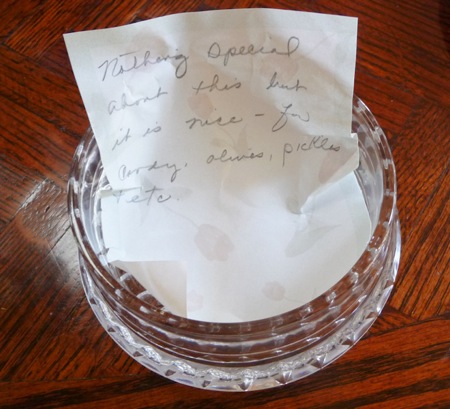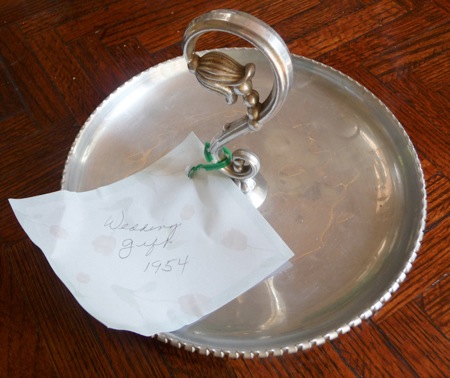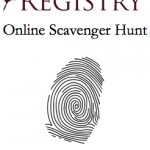Do You Know Where Your Stuff Has Been?
Sometimes I find an interesting old photo album or a piece of beautiful engraved silver at an estate sale, and I have to wonder, Where did this come from?
It’s a sad fact that so many family heirlooms end up in the hands of antique dealers and collectors instead in the homes of family members. Fortunately for me, I seem to come from a line of women who took a few extra steps to keep their treasures from becoming lost from the family.
I’m still finding notes that my mom (and my mother-in-law, too) tucked inside jewelry boxes, vases, and books. Sometimes the notes tell a story of how the item was acquired, and sometimes the story is more about the item itself.

One of my favorite heirloom histories is actually pretty short,
“Nothing special about this but it is nice — for candy, olives, pickles & etc.”
When you stop and think about it, that note is actually liberating for someone who might feel overwhelmed by inherited treasures and reluctant to part with anything that just might turn out to have some great sentimental value. No one wants to hear their aunt say, “Why in the world would you get rid of that wonderful so and so? It was a gift from Mr. Whozit and it’s been halfway around the world and back.”
Mom’s notes clued us in to wedding gifts, special memories, and a few items she wanted given to special people.
Of course, all these little bits of paper can become separated from the item and eventually lost. And there will be a time when someone wonders Who wrote the notes? and What family wedding?

If you are the keeper of the stuff in your family, it can be a good idea to use some kind of form template or form to help you record the history of your keepsakes. It’s easy to forget to include a physical description or measurements when you are busy telling stories about an item, but this information can be vital if the item is lost or stolen. Using a template also allows you to take your time and involve other family members, as well as collect photos to illustrate your heirloom history.
My form is short and simple, but it reminds me to include all the important facts. I’ve included a link for you to download a copy at the end of this article.
Some items in your family archive may be special keepsakes; these are great candidates for online registration with The Heirloom Registry. The unique serial number can be attached directly to your heirloom and your notes added by cut-and-paste to the Heirloom Registry online form.
Any family member can write an heirloom history; it’s a great project for a family gathering or something special to do with school-age children. And, a handwritten history is even more special when the careful script is made by someone you love. Scan the handwritten sheets and save a digital image to attach online; keep the originals in your own heirloom notebook. This notebook (or file folder) is also a good place to preserve the special notes you may find tucked inside various items.
Mom was right. The crystal bowl might not have been a wedding gift, but it is pretty nice and I use it often “for candy, olives, pickles, & etc.”
Link to download my Heirloom History form in editable text format —






Thank you so much for the Heirloom Form — hadn’t thought of this and such an important step.
Great tips for keeping track of family heirlooms! I really like your history form, too; simple, yet complete!